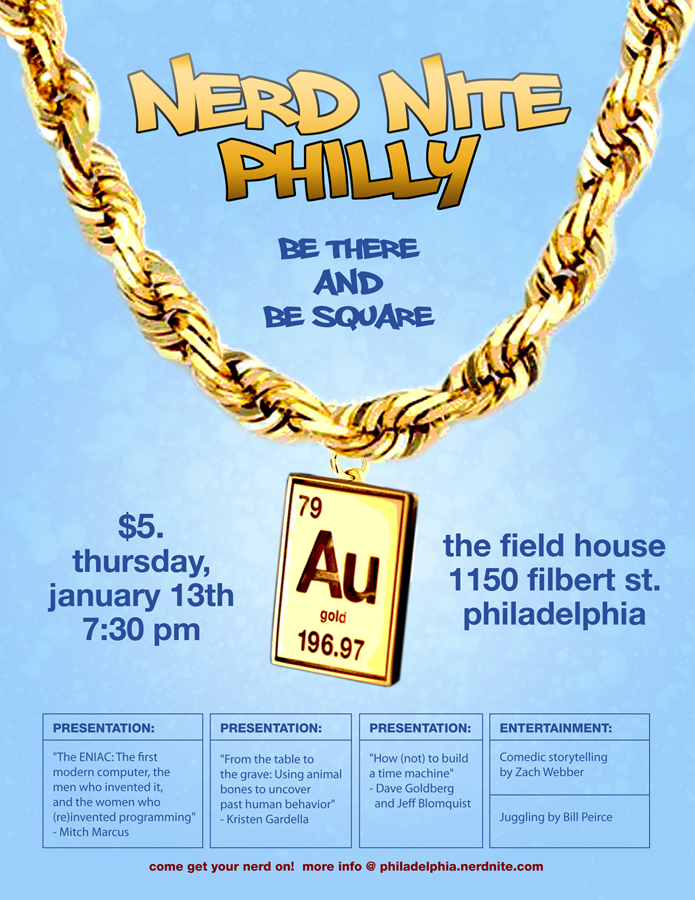Philly Nerd Nite No. 2, Jan. 13, 2011
Hey Nerds of Philadelphia!
The next Nerd Nite is drawing near. This time, we’ll hear about the first computer (Philly’s own ENIAC), how animal bones can teach us about ancient humans, and time travel. For entertainment in between talks: comedy and juggling!
Set the time and space coordinates on your TARDIS for January 13, 2011 (doors at 7:30, show at 8:00) at The Field House at 1150 Filbert Street. Note that we’ll be *upstairs* this time and removed from the football noise. The $5 cover gets you cheap drinks and over an hour of excellent nerdosity.
Speakers:
“The ENIAC: The first modern computer, the men who invented it, and the women who (re)invented programming” by Mitch Marcus, Univ. of Pennsylvania
The ENIAC, first demonstrated publically at Penn on Valentine’s Day, 1946, was the world’s first general purpose electronic computer. With 100,000 parts individually soldered together, it was 100 times more complex than any previous electronic device, and believed to be impossible by the best experts of the day. How did the machine work? Who were the visionaries who thought such a machine was possible, and how did they actually get it to work? Who were the original programmers, why were they all women, and did they really invent programming?
Bio: Mitch Marcus is a professor at Penn, where his day job is figuring out how to get computers to automatically misunderstand human language half as well as people do. In his spare time, he studies programming manuals for long-gone 30 ton computers, just in case he finds one at a yard sale.
“From the table to the grave: using animal bones to uncover past human behavior” by Kristen Gardella, Univ. of Pennsylvania
Zooarchaeology is the study of animal bones recovered from archaeological sites. Archaeologists use animal bones to help them understand not only the life history of animals, but also complex human behaviors such as foodways, ritual practices, herding strategies and long-distance trade. Highlighting several sites from Latin America, this talk will address how faunal data is gathered from archaeological sites and how it is interpreted to understand human and animal interactions in the past.
Bio: Kristen Gardella is a PhD student in the Department of Anthropology at the University of Pennsylvania, specializing in Zooarchaeology of the Andes. She has a BA from Bucknell University and a MA from the University of Chicago and has spent more than 16 years working on archaeological sites throughout North, Central and South America. She teaches in the Department of Anthropology and Sociology at Ursinus College and is the project zooarchaeologist for a multidisciplinary investigation studying climate change and early hunter-gatherer societies in the high Andes.
“How (not) to build a time machine” by Dave Goldberg, Drexel Univ. and Jeff Blomquist, Boeing and Widener Univ.
We’ll give a hands-on guide for the practical time-traveler, from basic design specs to how to avoid paradoxes. Most importantly, we’ll discuss whether you should attempt (or if it’s even possible) to kill your grandfather when you encounter him in the past, and how to explain yourself when you see him again next Thanksgiving.
Bio: Dave Goldberg and Jeff Blomquist are the authors of “A User’s Guide to the Universe: Surviving the Perils of Black Holes, Time Paradoxes, and Quantum Uncertainty.” Dave is an associate professor of physics at Drexel University, where he works on theoretical and observational cosmology. He has contributed to Slate, the LA Times, and has appeared on WNYC’s Studio 360. He also writes the “Ask a Physicist” column for io9.com. Jeff Blomquist is an engineer at Boeing Aerospace and adjunct professor of Astronomy at Widener. He drew the illustrations in “A User’s Guide” all by himself! He lives in Philadelphia and has only recently stopped sleeping on a couch.
Featuring entertainment: Comedic storytelling by Zach Webber and Juggling by Bill Peirce
See you there!
Flyer by Jon Oliver.
